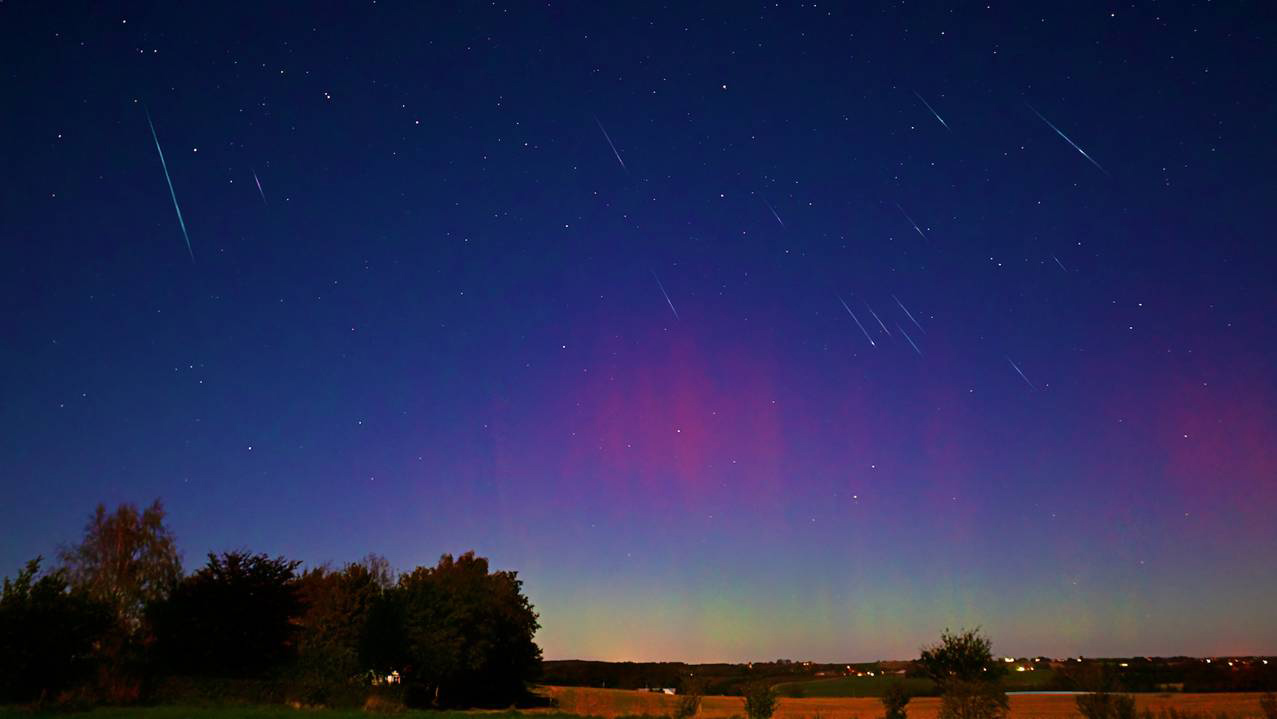
One of the most famous of all the "shooting star" displays, the Draconid meteor shower, will peak tonight (Oct. 9), but the celestial light show may be disappointing for casual stargazers.
The Draconid meteor shower is created by the periodic Comet 21P/Giacobini-Zinner and is sometimes referred to as "Giacobinids." It is known to be the source of two of the greatest meteor displays in the 20th century; a dazzling show in 1933, and then again in 1946. Lesser showers graced the October night sky in 1926, 1952, 1985, 1998 and 2011.
Most years (and this likely will be one of them) tend to bring few, if any, Draconids at all. An intense shower seems to occur only when the Earth passes just inside Comet Giacobini-Zinner's orbit shortly after the comet itself has gone by. Apparently, the meteoroids that cause the shower left the comet's nucleus relatively recently. They had no time to disperse all the way around the comet’s orbit. Rather, they remain in a thin ribbon not very far ahead of and behind the comet. [See amazing Draconid meteor shower photos from past displays]
How to see the Draconid meteor shower
Although it isn't very likely that any Draconids will be seen this year since the comet is nowhere near the Earth's orbit, the moon is just past new and just a crescent low in the southwest sky — a favorable circumstance to check and see if there is any unexpected activity going on this evening. Here are some tips to see them:
Begin your stargazing night by gazing straight up at the sky overhead as soon as it gets dark. No special equipment is needed, just an open sky, a lawn chair or blanket on the ground, a watch, and a note pad of any Draconids seen.
The Draconid meteor shower radiant — the point from which the shower appears to radiate out from — is near the head of the constellation Draco (the Dragon), hence the name of the shower. A shower member is a meteor whose path, if traced backward, would intersect this spot.
Get the Space.com Newsletter
Breaking space news, the latest updates on rocket launches, skywatching events and more!
Dazzling Draconids of times past
While the 2013 Draconid meteor shower may be a bust, that wasn't the case in past displays.
As darkness fell on the evening of Oct. 9, 1946, many hopeful eyes were turned skyward. Thirteen years earlier, in 1933, Comet Giacobini-Zinner brought in its wake a brief, intense shower of up to 500 shooting stars per minute over Europe! Now the comet was back, and both it and the Earth seemed correctly positioned for a replay.
This time, it would be North America's turn and despite a full moon and widespread cloudiness over the eastern and central U.S., skywatchers were not disappointed. In Chicago, Wagner Schlesinger, director of the Adler Planetarium, counted 149 "flashing projectiles" in 10 minutes. Not bad, considering the moonlit sky was more than 80 percent cloud covered! In St. Louis, two observers watched the Draconids through holes in an altocumulus cloud deck "like white snowflakes in a minor snowstorm."
Across the western U.S., where skies were mostly clear, rates of 50 to 100 per minute were recorded, in spite of the bright moonlight.
Editor's note:If you snap an amazing Draconid meteor photo tonight and you'd like to share it with SPACE.com for a story or image gallery, send images, comments and location information to managing editor Tariq Malik at spacephotos@space.com.
Joe Rao serves as an instructor and guest lecturer at New York's Hayden Planetarium. He writes about astronomy for Natural History magazine, the Farmer's Almanac and other publications, and he is also an on-camera meteorologist for News 12 Westchester, N.Y.
Join our Space Forums to keep talking space on the latest missions, night sky and more! And if you have a news tip, correction or comment, let us know at: community@space.com.

Joe Rao is Space.com's skywatching columnist, as well as a veteran meteorologist and eclipse chaser who also serves as an instructor and guest lecturer at New York's Hayden Planetarium. He writes about astronomy for Natural History magazine, Sky & Telescope and other publications. Joe is an 8-time Emmy-nominated meteorologist who served the Putnam Valley region of New York for over 21 years. You can find him on Twitter and YouTube tracking lunar and solar eclipses, meteor showers and more. To find out Joe's latest project, visit him on Twitter.









